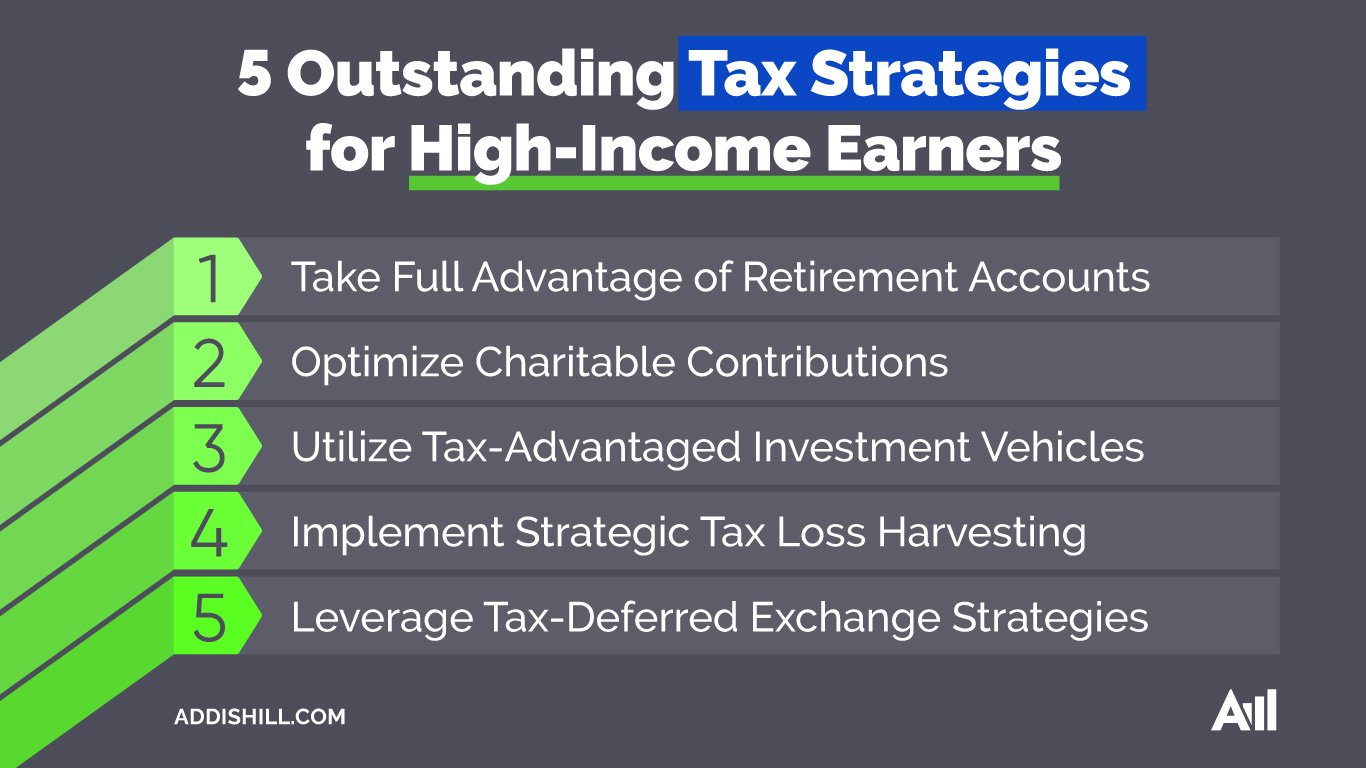Table of Contents
As a high-income earner, navigating the complex world of taxes is crucial to maximizing your wealth-building potential. Taxes can significantly impact your overall financial picture, but with careful planning and the right strategies, you can optimize your tax efficiency and minimize your liabilities. In this blog, I will share five outstanding tax strategies that have proven effective for high-income earners. By implementing these strategies, you can take control of your tax obligations and accelerate your journey toward financial success.

Take Full Advantage of Retirement Accounts
Retirement accounts are not only vehicles for saving for the future but also powerful tools for reducing your taxable income in the present. As a high-income earner, contributing the maximum allowed amount to retirement accounts such as 401(k)s and IRAs is a smart move. By doing so, you not only save for retirement but also enjoy immediate tax benefits. Contributions to these accounts are typically made with pre-tax dollars, meaning they lower your current taxable income. Additionally, some retirement accounts offer tax-free growth, allowing your investments to compound over time without incurring annual taxes. By maximizing your contributions to retirement accounts, you can potentially move into a lower tax bracket and retain more of your hard-earned income.
Optimize Charitable Contributions
Charitable giving provides an opportunity to support causes you care about while also reducing your taxable income. For high-income earners, optimizing charitable contributions can be a powerful tax strategy. When you donate to qualified charities, you can deduct the contributions from your taxable income, potentially resulting in substantial tax savings. However, it’s important to approach charitable giving strategically. Consider donating appreciated assets, such as stocks or real estate, instead of cash. By doing so, you can maximize your tax benefits by avoiding capital gains taxes on the appreciated assets while still receiving a deduction for the fair market value of the donation. Establishing a donor-advised fund is another strategy worth considering. This allows you to make a significant contribution in one year and distribute the funds to charities over time while still receiving immediate tax benefits.
Utilize Tax-Advantaged Investment Vehicles
High-income earners should explore investment vehicles that offer tax advantages. One example is investing in municipal bonds, which can provide tax-free income. Interest generated from municipal bonds is often exempt from federal taxes and, in some cases, state taxes. By including these bonds in your investment portfolio, you can generate tax-efficient income and reduce your overall tax burden. Additionally, consider utilizing tax-efficient funds or exchange-traded funds (ETFs). These investment vehicles are designed to minimize taxable distributions, allowing you to optimize your after-tax returns. By strategically incorporating tax-advantaged investments into your portfolio, you can maximize your wealth accumulation while minimizing your tax liabilities.
Implement Strategic Tax Loss Harvesting
Tax loss harvesting is a technique where you intentionally sell investments that have declined in value to offset capital gains and potentially reduce your taxable income. This strategy is particularly valuable for high-income earners who may have significant capital gains to offset. By carefully managing your investment portfolio and strategically realizing losses, you can leverage tax loss harvesting to your advantage. However, it’s crucial to adhere to the rules set by the Internal Revenue Service (IRS). One such rule to keep in mind is the wash-sale rule, which disallows the deduction if you purchase a “substantially identical” security within 30 days of the sale. To implement tax loss harvesting effectively, work closely with a tax professional who can guide you through the process and ensure compliance with the IRS regulations.
Leverage Tax-Deferred Exchange Strategies
If you own real estate or other appreciated assets, leveraging tax-deferred exchange strategies can be a valuable tool to defer capital gains taxes. One commonly used strategy is a 1031 exchange. This allows you to exchange one investment property for another similar property while deferring the payment of capital gains taxes. By deferring taxes, you can preserve and reinvest the proceeds, potentially leading to greater wealth accumulation over time. It’s important to note that there are specific rules and regulations governing like-kind exchanges, so it’s crucial to consult with a tax professional or qualified intermediary to ensure compliance. By effectively implementing tax-deferred exchange strategies, high-income earners can optimize their real estate investments while managing their tax liabilities.
In conclusion
As a high-income earner, strategically managing your tax obligations is essential for maximizing your financial success. By implementing these five outstanding tax strategies—maximizing retirement accounts, optimizing charitable contributions, utilizing tax-advantaged investments, implementing tax loss harvesting, and leveraging tax-deferred exchanges—you can minimize your tax liabilities and accelerate your wealth-building journey. Remember, tax laws and regulations can change, so it’s crucial to work closely with a qualified tax professional who can provide personalized advice tailored to your unique circumstances. Start implementing these strategies today and unlock the full potential of your high income to create lasting wealth.

